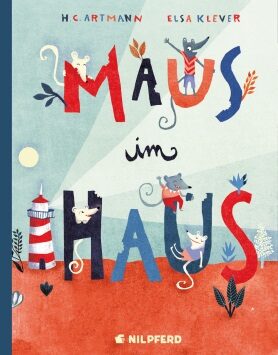Hans Carl ArtmannElsa Klever
Maus im Haus
[A mouse in the house]
- Nilpferd im G&G Verlag
- Vienna 2016
- ISBN 978-3-7074-5179-5
- 48 Pages
- 3 Suitable for age 4 and above
- Publisher’s contact details
Sample translations
On seals and mice: H.C. Artmann’s and Elsa Klever’s fantastic-realist picture book ‘Maus im Haus’ [‘A mouse in the house’]
Thus begins the story ‘Maus im Haus’ by the Austrian poet, writer and translator H.C. Artmann (1921-2000) – a beginning that bodes no ill but at the same time tickles our curiosity. We immediately prick up our ears, as though we had found ourselves in a cosy little huddle with a wise and humorous old story-teller who is just about to open a secret door onto the even more secret recesses of his own daydreams. We are teased at once by phrases such as ‘far, far away in the deepest depths of South America’, ‘trees [...] so dense and close together that [...] you can walk along on the tops of them without sinking in’, and we hear about Ompul himself – a moustachioed seal who was once a seaman and now works as a lighthouse keeper; and where? – close by Tierra del Fuego, the Land of Fire: where else?!
Lovers of a good story, be they young or old, don’t really need to know that H.C. Artmann was one of the most significant exponents of a new, experimental kind of poetry in post-war Europe, a writer given to poetic fantasies who delighted in ignoring the formal conventions of traditional poetry. All we need to do is to abandon ourselves to the magic of his narrative artistry – just as the illustrator Elsa Klever does in her colourful, clear-cut visualisation of this tale from 1979 (one of the few stories for children that Artmann ever wrote), full of lovable figures and twinkly-eyed dramatic effects. She demonstrates complete mastery of a realistic symbolism that is reduced to its bare essence, and which she conveys with a mixture of acrylic and spray painting, in conjunction with scenes manipulated on a computer. By these means she conjures up a symbolic world at once exciting and stimulating, the constituent parts of which both young and old can readily decode and then assimilate within the framework of their own sense of reality and their own imagination. Through her depictions of the characters and their surroundings she creates an unmistakable visual world that is in perfect harmony with Artmann’s fantastic realism. In addition, every page sports a capitalised word or phrase, the coloured letters of which reflect the palette of colours used in the accompanying illustration.
One day, then, Ompul returns from one of his shopping trips to the the nearby town. He is completely at one with himself and the world. Nothing could be more calm and peaceful than the image of him waddling up the steps to his lighthouse, wearing his old seaman’s cap and red-and-white-striped scarf and carrying his bag of shopping. Everything seems set for a relaxing weekend when, having attended to his responsibilities up in the control room by the lamphouse and returned to his private realm downstairs, he settles down in the rocking chair in his parlour, leafs through the local paper (the ‘Tierra del Fuego Times’), and abandons himself to his day dreams about the stars, about viewing our wonderful blue planet from outer space, about going to the cinema with a penguin, about riding a motor bike... But his fantasies – Elsa Klever’s illustrations of which appear to take shape entirely of their own accord – are suddenly interrupted by a plain and simple, but for that very reason all the more penetrating ‘SQUEAK!’ This marks the beginning of a wonderfully jolly cat-and-mouse – sorry: cat-and-seal – escapade. Whilst the successive phases of this ever-intensifying contest do not all pan out to Ompul’s advantage, at the same time it never descends to the in-your-face brutalist, black-and-white level of the Tom and Jerry stories.
In Artmann, both the seal and the mice are representative of creatures forged by the adversities of existence, pragmatists who draw on their cunning as seal and mouse respectively in order to deploy their talents and their survival strategies within their neighbour’s domain, without ever doing the other down, let alone doing them harm. Ompul meets the cunning of the mice with the wisdom of his years and the power of his imagination. At the end of the story neither rates as a ‘Silly Billy’, and the almost symbiotic fraternity within the lighthouse can look forward to their next tussle. There is no question of boredom descending either on cheerful old Ompul and his house mice, or on the book’s readers, whether young or old. Adults will relish Artmann’s veiled irony, children will delight in the slapstick humour and the fantastic world evoked by the illustrations. And common to both is the realisation that we never know what kind of a visitor an evening might bring. What’s making that noise underneath my desk?!
Translated by John Reddick

By Siggi Seuß
Siggi Seuß, freelance journalist, radio script writer and translator, has been writing reviews of books for children and young people for many years.
Publisher's Summary
Ompül, the seal, lives by the sea, tending a lighthouse and dreaming away his days. He has time to wonder…What would it be like to be a mountaineer? Or a cowboy? Or an astronaut! Just imagine! But then reality knocks. A gang of naughty mice moves into his cupboard, nibbling up all the cheese and biscuits, partying and even using his telephone! What is Ompül to do?
An enchanting, clever story by the famous Austrian writer, H.C. Artmann. Elsa Klever designed the charming and funny illustrations.
(Text: Nilpferd im G&G Verlag)
